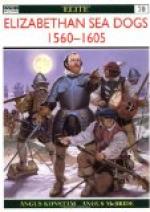No sooner had the immediate danger of a great combined attack on England passed away than Elizabeth returned to Drake’s plan for a regular raid against New Spain, though it had to be one that was not designed to bring on war in Europe. Drake, who was a member of the Navy Board charged with the reorganization of the fleet, was to have command. The ships and men were ready. But the time had not yet come.
Next year (1584) Amadas and Barlow, Sir Walter Raleigh’s two prospectors for the ‘plantation’ of Virginia, were being delighted with the summer lands and waters of what is now North Carolina. We shall soon hear more of Raleigh and his vision of the West. But at this time a good many important events were happening in Europe; and it is these that we must follow first.
William of Orange, the Washington of Holland, was assassinated at Philip’s instigation, while plots to kill Elizabeth and place Mary on the throne began to multiply. The agents were executed, while a ’Bond of Association’ was signed by all Elizabeth’s chief supporters, binding them to hunt down and kill all who tried to kill her—a plain hint for Mary Queen of Scots to stop plotting or stand the consequences.
But the merchants trading with Spain and Portugal were more than ever for keeping on good terms with Philip because the failure of the Spanish harvest had induced him to offer them special protection and encouragement if they would supply his country’s needs at once. Every available ton of shipping was accordingly taken up for Spain. The English merchant fleet went out, and big profits seemed assured. But presently the Primrose, ‘a tall ship of London,’ came flying home to say that Philip had suddenly seized the merchandise, imprisoned the men, and taken the ships and guns for use with the Great Armada. That was the last straw. The peaceful traders now saw that they were wrong and that the fighting ones were right; and for the first time both could rejoice over the clever trick by which John Hawkins had got his own again from Philip. In 1571, three years after Don Martin’s treachery at San Juan de Ulna, Hawkins, while commanding the Scilly Island squadron, led the Spanish ambassador




